Minimal membrane docking requirements revealed by reconstitution of Rab GTPase-dependent membrane fusion from purified components
- PMID: 19826089
- PMCID: PMC2764952
- DOI: 10.1073/pnas.0903801106
Minimal membrane docking requirements revealed by reconstitution of Rab GTPase-dependent membrane fusion from purified components
Abstract
Rab GTPases and their effectors mediate docking, the initial contact of intracellular membranes preceding bilayer fusion. However, it has been unclear whether Rab proteins and effectors are sufficient for intermembrane interactions. We have recently reported reconstituted membrane fusion that requires yeast vacuolar SNAREs, lipids, and the homotypic fusion and vacuole protein sorting (HOPS)/class C Vps complex, an effector and guanine nucleotide exchange factor for the yeast vacuolar Rab GTPase Ypt7p. We now report reconstitution of lysis-free membrane fusion that requires purified GTP-bound Ypt7p, HOPS complex, vacuolar SNAREs, ATP hydrolysis, and the SNARE disassembly catalysts Sec17p and Sec18p. We use this reconstituted system to show that SNAREs and Sec17p/Sec18p, and Ypt7p and the HOPS complex, are required for stable intermembrane interactions and that the three vacuolar Q-SNAREs are sufficient for these interactions.
Conflict of interest statement
The authors declare no conflict of interest.
Figures
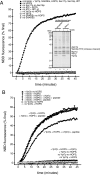
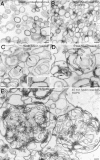
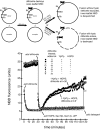
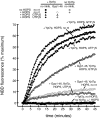
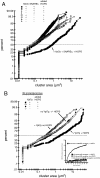
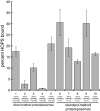
Comment in
-
Organelle docking: R-SNAREs are late.Proc Natl Acad Sci U S A. 2009 Nov 24;106(47):19745-6. doi: 10.1073/pnas.0911425106. Epub 2009 Nov 18. Proc Natl Acad Sci U S A. 2009. PMID: 19923425 Free PMC article. No abstract available.
Similar articles
-
Phosphorylation of the effector complex HOPS by the vacuolar kinase Yck3p confers Rab nucleotide specificity for vacuole docking and fusion.Mol Biol Cell. 2012 Sep;23(17):3429-37. doi: 10.1091/mbc.E12-04-0279. Epub 2012 Jul 11. Mol Biol Cell. 2012. PMID: 22787280 Free PMC article.
-
Membrane fusion catalyzed by a Rab, SNAREs, and SNARE chaperones is accompanied by enhanced permeability to small molecules and by lysis.Mol Biol Cell. 2011 Dec;22(23):4635-46. doi: 10.1091/mbc.E11-08-0680. Epub 2011 Oct 5. Mol Biol Cell. 2011. PMID: 21976702 Free PMC article.
-
The major role of the Rab Ypt7p in vacuole fusion is supporting HOPS membrane association.J Biol Chem. 2009 Jun 12;284(24):16118-16125. doi: 10.1074/jbc.M109.000737. Epub 2009 Apr 21. J Biol Chem. 2009. PMID: 19386605 Free PMC article.
-
Membrane fusion: five lipids, four SNAREs, three chaperones, two nucleotides, and a Rab, all dancing in a ring on yeast vacuoles.Annu Rev Cell Dev Biol. 2010;26:115-36. doi: 10.1146/annurev-cellbio-100109-104131. Annu Rev Cell Dev Biol. 2010. PMID: 20521906 Review.
-
Membrane dynamics and fusion at late endosomes and vacuoles--Rab regulation, multisubunit tethering complexes and SNAREs.Eur J Cell Biol. 2011 Sep;90(9):779-85. doi: 10.1016/j.ejcb.2011.04.007. Epub 2011 Jun 16. Eur J Cell Biol. 2011. PMID: 21683469 Review.
Cited by
-
Phosphatidic acid induces conformational changes in Sec18 protomers that prevent SNARE priming.J Biol Chem. 2019 Mar 1;294(9):3100-3116. doi: 10.1074/jbc.RA118.006552. Epub 2019 Jan 7. J Biol Chem. 2019. PMID: 30617180 Free PMC article.
-
HOPS drives vacuole fusion by binding the vacuolar SNARE complex and the Vam7 PX domain via two distinct sites.Mol Biol Cell. 2011 Jul 15;22(14):2601-11. doi: 10.1091/mbc.E11-02-0104. Epub 2011 May 25. Mol Biol Cell. 2011. PMID: 21613544 Free PMC article.
-
Key role of polyphosphoinositides in dynamics of fusogenic nuclear membrane vesicles.PLoS One. 2011;6(9):e23859. doi: 10.1371/journal.pone.0023859. Epub 2011 Sep 8. PLoS One. 2011. PMID: 21931619 Free PMC article.
-
Human Rab small GTPase- and class V myosin-mediated membrane tethering in a chemically defined reconstitution system.J Biol Chem. 2017 Nov 10;292(45):18500-18517. doi: 10.1074/jbc.M117.811356. Epub 2017 Sep 22. J Biol Chem. 2017. PMID: 28939769 Free PMC article.
-
Intrinsic tethering activity of endosomal Rab proteins.Nat Struct Mol Biol. 2011 Dec 11;19(1):40-7. doi: 10.1038/nsmb.2162. Nat Struct Mol Biol. 2011. PMID: 22157956 Free PMC article.
References
Publication types
MeSH terms
Substances
Grants and funding
LinkOut - more resources
Full Text Sources
Other Literature Sources
Molecular Biology Databases

